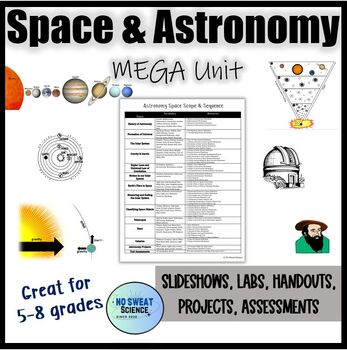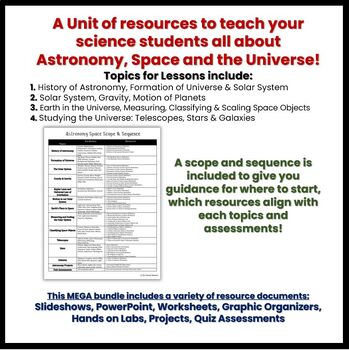Astronomy, Solar System, Space and Universe Mega Bundle Lessons and Assessments
No Sweat Science
77 Followers

Includes Google Apps™
This bundle contains one or more resources with Google apps (e.g. docs, slides, etc.).
Products in this Bundle (61)
showing 1-5 of 61 products
Bonus
Astronomy and Space Unit Scope and Sequence
Description
Designed to spark curiosity and foster a love for astronomy and science!
This unit collection covers everything from the fundamentals of celestial mechanics to the latest discoveries in astrophysics.
⭐Empower your middle school science students to reach for the stars as they explore the mysteries of galaxies, planetary systems, and cosmic phenomena.
⭐With this Mega Bundle, teaching about space has never been more exciting or accessible. Transform your classroom into a hub of cosmic exploration and ignite a passion for discovery that will last a lifetime!
Total Pages
Answer Key
N/A
Teaching Duration
N/A
Report this resource to TPT
Reported resources will be reviewed by our team. Report this resource to let us know if this resource violates TPT’s content guidelines.
Standards
to see state-specific standards (only available in the US).
NGSSMS-ESS1-2
Develop and use a model to describe the role of gravity in the motions within galaxies and the solar system. Emphasis for the model is on gravity as the force that holds together the solar system and Milky Way galaxy and controls orbital motions within them. Examples of models can be physical (such as the analogy of distance along a football field or computer visualizations of elliptical orbits) or conceptual (such as mathematical proportions relative to the size of familiar objects such as students’ school or state). Assessment does not include Kepler’s Laws of orbital motion or the apparent retrograde motion of the planets as viewed from Earth.
NGSSMS-ESS1-3
Analyze and interpret data to determine scale properties of objects in the solar system. Emphasis is on the analysis of data from Earth-based instruments, space-based telescopes, and spacecraft to determine similarities and differences among solar system objects. Examples of scale properties include the sizes of an object’s layers (such as crust and atmosphere), surface features (such as volcanoes), and orbital radius. Examples of data include statistical information, drawings and photographs, and models. Assessment does not include recalling facts about properties of the planets and other solar system bodies.



